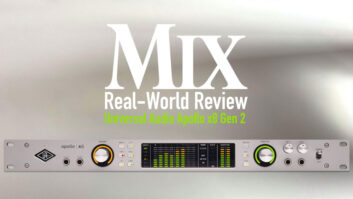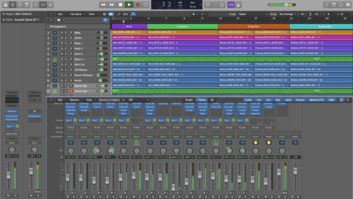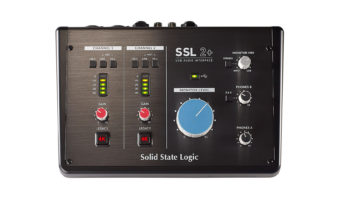Universal Audio makes some of the finest plug-ins available today. With the UAD-2 Live Rack, a 16-channel 1U MADI box that allows Universal Audio plug-ins to be used in a sound reinforcement situation, UA’s plug-ins are as accessible in the live sound arena as they are in the recording studio. Last December I put them to the test during a dozen Amy Grant/Vince Gill shows with special guest Rodney Crowell at Nashville’s legendary Ryman Auditorium.
The UAD-2 Live Rack incorporates four SHARC DSP core chips for processing. The device supports 16 channels of audio (user-configured as either 16 mono channels, eight stereo channels or any combination of the two) and each channel can host up to eight UAD Powered Plug-Ins, making the potential massive. The box features dual-redundant internal power supplies with fail-over detection ensuring uninterrupted performance.
The Live Rack system is controlled by a Mac computer running the Live Rack application connected via Thunderbolt. Up to four Live Racks (providing up to 64 channels of processing) can be controlled with a single computer. The Live Rack application is designed to provide simple and quick operation during a show; it does exactly that and is incredibly intuitive and easy to use. While I didn’t have the opportunity to use the Live Rack app with a touchscreen display, it is worth noting that it is optimized for touch control with a Mac-compatible touchscreen display, which I’m sure will be a factor for many users. The only real downside of the Live Rack application is that Live Rack won’t work on a computer that has the Universal Audio studio software installed on it (the Live Rack software is an entirely different application than the studio software).
Since all of the audio processing is done in the UAD-2 Live Rack, the computer is acting simply as a controller and doesn’t need anything exceptional as far as processing. I recommend getting a dedicated Mac to control the device. Computer requirements are minimal: an Apple Mac computer with 6 GB of available storage running High Sierra with an available Thunderbolt port (Macs with Thunderbolt 1 or Thunderbolt 2 ports require an adapter). It is not currently qualified with Mojave but there are no known issues.
Live Rack provides incredible low-latency performance. The overall system throughput latency, with non-upsampled plug-ins or when no plug-ins are assigned, is 73 samples. While the majority of UAD’s plug-ins are non-upsampled, some are; in those instances, a negligible amount of additional latency (typically 0-89 samples depending on the plug-in and sample rate) added to the signal, making the maximum latency 162 samples (1.7ms @ 96kHz). A list of upsampled UAD plug-ins and their precise latency values can be found in the UAD plug-ins manual.
The processor is available in two bundled plug-in configurations (see sidebar). The UAD-2 Live Rack Core ($2,999) includes a basic plug-in package; UAD-2 Live Rack Ultimate ($5,999) is packaged with a massive collection of more than 90 UAD plug-ins. It’s important to note that existing UAD plug-in users can use their UAD plug-in licenses with UAD-2 Live Rack, though a small number of UAD plug-ins are incompatible with UAD-2 Live Rack (the current list is available at https://help. uaudio.com).
I spent a day with the UAD-2 Live Rack at Nashville’s Blackbird Studio, where I listened to the plug-ins through the box on a wide variety of source material. I’m a longtime user of UAD plug-ins, so there were no surprises, but wrapping my head around using these studio tools in a live sound situation was a new (and exciting!) concept for me.
Encouraged by the experience, I decided to use the UAD-2 Live Rack for the Amy Grant/Vince Gill shows. In 2018, the Ryman Auditorium renovated its sound system—a process that included purchasing newYamaha Rivage PM7 consoles at FOH and monitors. Adding a MADI card to the FOH PM7 made interfacing with the Live Rack a cakewalk, and a dozen shows in the same venue gave me the perfect opportunity to put Live Rack to the test.
I couldn’t have been more pleased with the box’s performance. During different shows, I used the LA-2A and 1176 with the Precision De-Esser on vocals and experienced flawless results. The EMT 140 reverb sounded simply stunning in the room; I used it as my primary vocal reverb for all 12 shows. The Tube Tech CL-1B is one of my favorites in the studio—it worked equally well on vocals, acoustic guitar and bass for the live performances. The AMS RMX16 was my snare drum reverb of choice for every show, and the Fairchild 670/Harrison 32C provided the perfect saxophone chain.
Live Rack stores snapshot configuration files, making it easy to recall show settings for specific songs or song sections. Snapshot configurations can be recalled via MIDI or with the Soundcraft Vi CUE function when using the box in conjunction with a Soundcraft Vi desk.
Universal Audio has arguably the most-used plug-in collection in the studio today, and UAD-2 Live Rack provides an easy and reliable way to take that collection into the live sound arena. Live sound engineers who want to use external plug-ins should give this device top consideration.
Universal Audio • www.uaudio.com
Nashville based Russ Long has been producing, engineering and mixing music for three decades. He spends the bulk of his time working in his Dangerland mix room where he also does console R&D for the Yamaha corporation.







